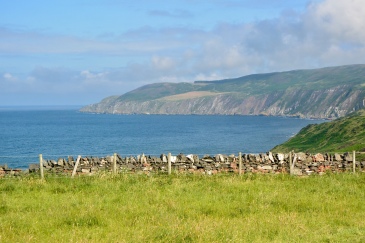Cove to Siccar Point

On our last day in Lower Burnmouth, we chose a walk on the Berwickshire Coastal Path from Cove to Siccar Point. However, the morning was wet and drizzly so we decided to postpone that till the afternoon when the forecast was better. Our first stop then became the ruined Dunglass Collegiate Church, built for Sir Alexander Home around 1443. We didn’t realise it had a connection to our later walk until we saw this memorial to Sir James Hall. It’s not terribly legible, but the important reference is to his favourite science of geology.
 A nearby information board explained that Sir James (1761-1832) was a friend of James Hutton, the father of modern geology. In 1788 he and mathematician John Playfair accompanied Hutton on a boat-trip from Dunglass to see nearby rock formations at Siccar Point. The expedition convinced them of Hutton’s new theory that the Earth was not thousands but millions of years old.
A nearby information board explained that Sir James (1761-1832) was a friend of James Hutton, the father of modern geology. In 1788 he and mathematician John Playfair accompanied Hutton on a boat-trip from Dunglass to see nearby rock formations at Siccar Point. The expedition convinced them of Hutton’s new theory that the Earth was not thousands but millions of years old.
After giving that some serious thought, we had a bit of fun before leaving!
We then headed to the nearby village of Cockburnspath, the eastern end of no fewer than three long-distance footpaths: the Southern Upland Way, the Sir Walter Scott Way and the Berwickshire Coastal Path. Despite this, it appeared not to boast any kind of café. However, it’s a pretty little place with an unusual round tower on its parish church.
The Market Cross was erected in 1503 by James IV of Scotland to mark his marriage to Margaret Tudor, daughter of Henry VII of England, to whom he presented the lands of Cockburnspath as part of her dowry. This was known as the Marriage of the Thistle and the Rose, representing the Scottish and English national symbols, and the cross has carved emblems of a thistle on two of its faces and a rose on the other two.
Still in search of sustenance we set of for Dunbar. No photographs here – as soon as we arrived we were dive-bombed by a seagull. I heard John cry out behind me as a torrent of guano shot past me, and I assumed it had hit him. In fact, the gull had attacked his head and he was bleeding. Our next quest was therefore for antiseptic wipes, and once John was cleaned up we had lunch – fortunately no shortage of cafes in Dunbar!
The weather having improved as predicted, we got our afternoon walk. The starting point, Cove, is one of the villages with memorials to the East Coast Fishing Disaster of 1881, which you can see in my earlier post. The natural harbour here is, unusually, accessed via a tunnel. We were already finding the rock formations interesting.
Climbing to the clifftops, we had great views back down to the harbour and a natural sandstone arch known as Hollow Rock.
As we continued along the cliffs we could see the Pease Bay Leisure Park coming into view. It’s a beautiful location, but I’m not sure I’d want to spend my holiday in amongst so many identikit chalets.
Having descended to Pease Bay, we then had to climb back up the other side. We saw neither slow toads nor attacking sheep.
The path took us through farmland to a minor road. Here we turned off for Siccar Point, passing the ruins of the 16th century St Helen’s Church – and a stray toilet! What’s that all about? Very strange.
The view from Siccar Point was stunning.
A very steep slope led down to the rocks to which James Hutton sailed in search of a visible “unconformity” to demonstrate his theories of the processes and cycles that shaped the Earth. We did not venture down the slope which looked rather precarious, and the unconformity was clear from above anyway. To spot it, have a look at the photograph below and compare it to the explanatory leaflet.
The grey, tilted rocks are Silurian greywacke formed in an ancient ocean. The much younger Upper Devonian Red Sandstone above it formed on land 65 million years later, during which time the older rocks were changed by folding, faulting, uplift and erosion. Hutton’s Unconformity is what separates them, a time gap in the normal geological sequence.


After our geology lesson, we turned round and returned to Cove. Out and back, this walk totalled 11km. As we approached the harbour we could see the tunnel exit clearly and, when we got to the carpark, I was delighted to see the same little mint-green Nissan that I’d spotted in Berwick a couple of days before.


Our day wasn’t quite finished yet. We dropped into St Abbs to complete our set of East Coast Fishing Disaster memorials, and had a walk round the harbour while we were there.
Then it was time to return to our cottage, have our final dinner, and pack up ready to leave the next morning. We’d had a wonderful week in Berwickshire.


















































![Top-20-Travel-Blogs-200×150[1]](https://i0.wp.com/www.holiday365.co.uk/blog/wp-content/uploads/2012/06/Top-20-Travel-Blogs-200x1501.png)
What a beautiful Harbour. I was interested to read about Hutton’s Unconformity.
Jude
LikeLike
I did a geology course once, many moons ago, so it brought it back to me.
LikeLike
I’m glad you enjoyed that area and had the time for a coastal walk. It is a very beautiful stretch of coast (well, that massive caravan park aside). That harbour at Cove is almost a perfect circle!
LikeLike
Yes it is, it’s very lovely!
LikeLike
Yikes, that gull! I’ve had my own bad encounters with them, from that jerk gull that stole my ice cream in Brighton, to one that crapped on my head in Penzance (and it was a lot of poop. More than you would think could come out of a bird), but I’ve never actually been attacked! Scary! Marcus would love all those rocks though – he’s always trying to point out different geological eras and such to me.
LikeLike
Judging by the amount of poop that shot past me, we’d have been drenched if it had hit us! That was one very angry bird.
LikeLiked by 1 person
Anabel – That cove is so inviting. And the photos seemed to show a lot of variety in the area. Good choice for a walking retreat 🙂 Susan
LikeLike
Thanks, Susan. We loved our week on the east coast and can’t wait to go back some day.
LikeLiked by 1 person
Slow toads, Silurian greywacke and a loo with a great view – this day had it all. The views are stunning. We were swooped by cranky seagulls once. It turned out they were nesting in the grass on the cliffs. I wonder if that was the source of your bird’s irritation. Poor John.
LikeLiked by 1 person
We wondered about nesting, but the nest must have been on the roof of a building if so because we’d just got out of the car. And the bird didn’t seem to bother about anyone else. Just John!
LikeLike
What a wonderful place to visit. Stunning scenery and plenty to see.
LikeLike
Yes, it was really lovely.
LikeLike
Such amazing photographs. I love the colours in the rocks and the sandstone, the shapes of the layers. What a fascinating walk that was and what a trove of good images you brought back. How lucky we are to live in this age of digital photography. I hate to think how much we’d all be spending if we were still taking slides or rolls. But I think what would happen is that we wouldn’t take more than one-tenth of what we do now! Oh, liked you bit of fun as well.
LikeLike
We’d probably have about 6 photos from that day! And 4 would probably be rubbish, but we wouldn’t know till we got then back.
LikeLike
Cove looks brilliant. A tunnel into the harbour…it’s like something the Famous Five or Secret Seven would stumble upon. The Slow Toad sign made me smile. I don’t think they’d stand a chance , the gulls in the area seem pretty vicious!
LikeLike
I know – I’ve never come across such a tunnel before. And you’re probably right about toads vs gulls!
LikeLike
Hi Anabel – our geology class leader U3A’s hero is James Hutton … and so keeps reminding us about Siccar Point and its history … he’s been there. Gorgeous photos and captions to go with them.
Crazy critter attacks … glad to see all are safe … while frankly that toilet would have been useful when you visited your friends the other day!!
Take care and I’ve something to email you … and the rock formations I’ve a post to do when I visited a Fashion House of all things in London strange but true! More anon – all the best – Hilary
LikeLike
Thanks Hilary, how fabulous that this struck a chord with you. I chuckled at the toilet comment and am intrigued by your last paragraph.
LikeLike